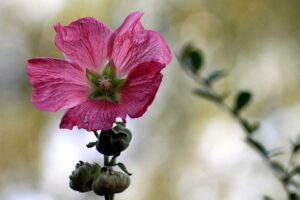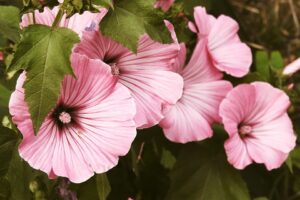 Malva sylvestris (Mallow) Flower extract*
Malva sylvestris (Mallow) Flower extract*
A moderate purplish red that is paler than magenta rose. It is used for its anti-inflammatory properties as well as emollient and astringent.
The Plant – Mallow (Malva sylvestris)
A species of Malva native to Europe (the British Isles and Iberia north to southern Scandinavia and east to Russia and the Caucasus), northern Africa (Morocco east to Egypt), and Asia (western and southwestern Asia, central Asia east to Kyrgyzstan, and east along the Himalaya to Bhutan).
It is a herbaceous annual, biennial, or perennial plant growing to 1-1.5 m (rarely 3 m) tall, with hairy stems and foliage. The leaves are alternate, palmately lobed, 2-10 cm long and 2-10 cm broad with three to seven shallow, rounded lobes and a serrated margin. The flowers are produced in clusters of two to six in the leaf axils, each flower 2-5 cm diameter, with five dark pink to purplish petals with a notch at the apex. The fruit is a disc-shaped schizocarp 5-8 mm diameter, containing 10-12 seeds, the seeds individually enclosed in a usually glabrous (occasionally hairy) mericarp. It has a chromosome count of 2n=42. Plants with hairy seed mericarps have sometimes been distinguished as M. sylvestris var. lasiocarpa Druce, and small plants from high altitude in the Atlas Mountains have sometimes been distinguished as M. sylvestris subsp. subacaulis Maire, though neither is widely regarded as distinct.
It occurs on dry, well-drained soils at altitudes from sea level up to 1,800 m in northern Europe and to 3,000 m in northwest Africa, growing on open, sunny sites with little competition from other plants. The flowers are usually pollinated by bees.
 It is often grown as an ornamental plant for its attractive flowers, produced for a long period through the summer. Numerous cultivars have been selected and named. Plants previously often described as Malva sylvestris var. mauritiana are now considered a Cultivar Group Malva sylvestris Mauritiana Group. Like other species of the genus Malva, it is high in mucilage content. It was historically used medicinally, internally as a demulcent using a seed extract or boiled young leaves, and externally as an emollients, for which it is still in some use as a natural skin treatment.
It is often grown as an ornamental plant for its attractive flowers, produced for a long period through the summer. Numerous cultivars have been selected and named. Plants previously often described as Malva sylvestris var. mauritiana are now considered a Cultivar Group Malva sylvestris Mauritiana Group. Like other species of the genus Malva, it is high in mucilage content. It was historically used medicinally, internally as a demulcent using a seed extract or boiled young leaves, and externally as an emollients, for which it is still in some use as a natural skin treatment.
The species has long been used as a natural dye, and the French name of the species mauve was used for the English name of the first synthetic dye of similar colour, better known as mauveine, which lead to the word mauve as an English colour name. It has been introduced to and become naturalised in eastern Australia and North America.
Other names sometimes used in cultivation included high mallow, tall mallow, wood mallow, wild mallow, cheese-flower, cheese-cake, pick-cheese, round dock, maul, and country-mallow. It is one of several species of different genera sometimes referred to as creeping charlie, a term more commonly applied to Glechoma hederacea (ground ivy).
The young leaves and shoots of this plant have been eaten since at least the 8th century BC. The plant s many uses gave rise to the Spanish adage, “A kitchen garden and mallow, sufficient medicines for a home.” The flowers and leaves are emollient and good for sensitive areas of the skin. It is applied as a poultice to reduce swelling and draw out toxins. Taken internally, the leaves reduce gut irritation and have a laxative effect. When common mallow is combined with eucalyptus (Eucalyptus globulus), it makes a good remedy for coughs and other chest ailments.
MAIN PROPERTIES: Anti-inflammatory, emollient, astringent, laxative.





